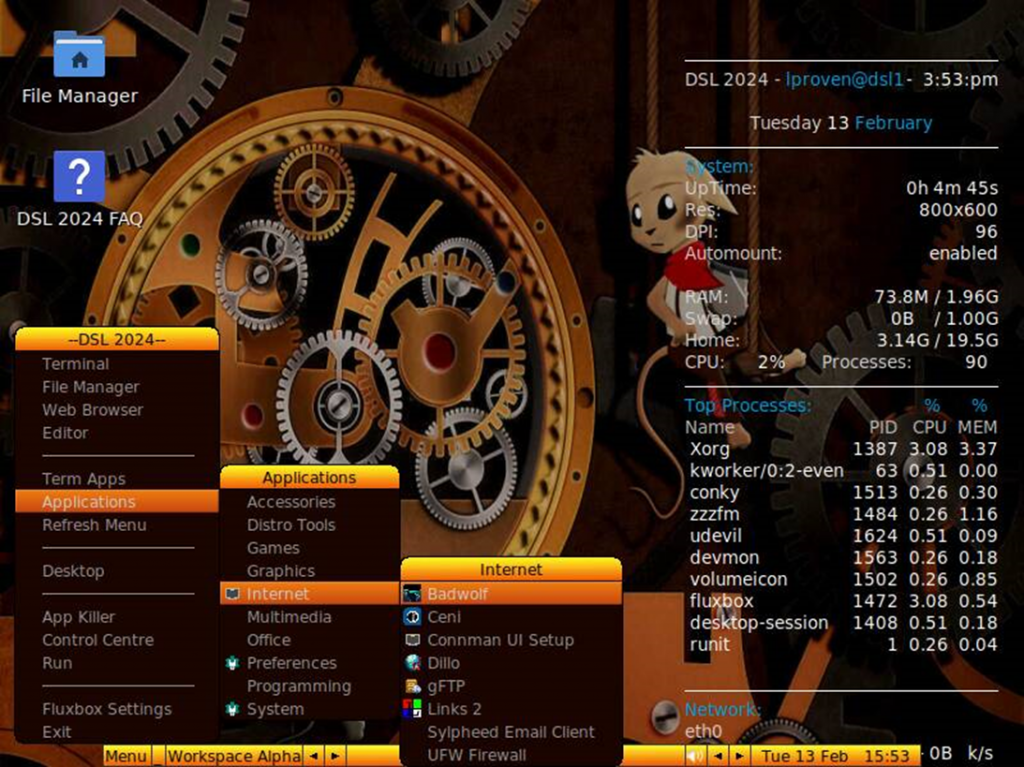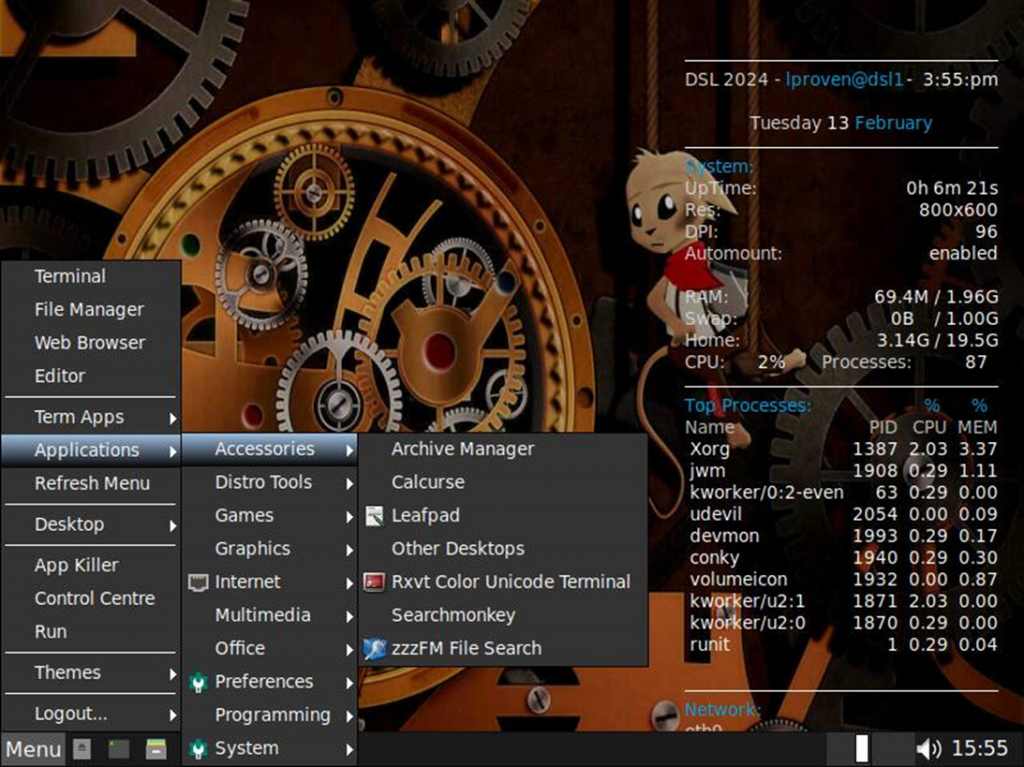Who can use such a lightweight distribution in 2024 and why?
19 years after the release of the original version and 12 years after the release of the latest release, the Linux distribution "Damn Small Linux "(DSL) is back. By the name, which can be literally translated as "damn small Linux", it is clear that the distribution should be extremely undemanding to the permanent and RAM of the device.
Initially, DSL was conceived as a tool for diagnosing and testing weak computer systems. The very first versions of the distribution weighed no more than 50 MB, while the latest version from February 2024 takes up 666 MB of disk space before installation.
As you can see, the distribution is noticeably fatter, but by the standards of modern systems, it is still quite lightweight and easily fits on a standard 700 MB CD.
The new release is produced by John Andrews, the original creator of the DSL. The long delay in the release of the new version may be due to the departure of Robert Shingledecker, Andrews partner, who shifted his efforts towards the even more lightweight and simple Tiny Core Linux.
The increased appetite for DSL 2024 is driven by the desire to provide support for a long list of outdated hardware, while maintaining access to modern technologies and software.
The new version of the distribution retains 2 of the 4 antiX environment managers: Fluxbox and JWM, which gives users the flexibility to configure the workspace.

Fluxbox working environment in DSL 2024

JWM Working Environment in DSL 2024
In addition, the distribution offers a choice between simple graphical web browsers like BadWolf (with JavaScript support) and Dillo (without JavaScript), which emphasizes the author's desire for minimalism without losing variability and functionality.
The included set of tools, described in detail on the official website of the project, includes everything you need for work and entertainment: from office applications and media players to text editors and simple games. At the same time, there is nothing superfluous in the assembly, which will appeal to those who appreciate simplification instead of being overloaded with unnecessary functions.
Once installed, DSL 2024 takes up approximately 3.3 GB of disk space and uses about 270 MB of RAM in idle mode, demonstrating its efficiency and minimal resource requirements. All localizations except English have been removed, which also highlights the focus on simplification and optimization.
Despite some technical flaws in the current alpha version, the overall impression of DSL 2024 remains positive. The size after installation is significantly smaller compared to other lightweight distributions, and the RAM consumption is half that of competitors, making it an attractive choice for users with limited resources.
The assembly is perfect, for example, for "reanimating" an ancient laptop, on which even old versions of Windows ungodly slow down.
The significant increase in size compared to the previous version of the DSL reflects the general tendency to "bloat" modern Linux distributions, but at the same time emphasizes the desire to keep the system functional.
Times have changed, and today it is not often possible to see a full-fledged, fully functional desktop Linux distribution that fits only on a CD-ROM. Good, John Andrews, damn good!
19 years after the release of the original version and 12 years after the release of the latest release, the Linux distribution "Damn Small Linux "(DSL) is back. By the name, which can be literally translated as "damn small Linux", it is clear that the distribution should be extremely undemanding to the permanent and RAM of the device.
Initially, DSL was conceived as a tool for diagnosing and testing weak computer systems. The very first versions of the distribution weighed no more than 50 MB, while the latest version from February 2024 takes up 666 MB of disk space before installation.
As you can see, the distribution is noticeably fatter, but by the standards of modern systems, it is still quite lightweight and easily fits on a standard 700 MB CD.
The new release is produced by John Andrews, the original creator of the DSL. The long delay in the release of the new version may be due to the departure of Robert Shingledecker, Andrews partner, who shifted his efforts towards the even more lightweight and simple Tiny Core Linux.
The increased appetite for DSL 2024 is driven by the desire to provide support for a long list of outdated hardware, while maintaining access to modern technologies and software.
The new version of the distribution retains 2 of the 4 antiX environment managers: Fluxbox and JWM, which gives users the flexibility to configure the workspace.

Fluxbox working environment in DSL 2024

JWM Working Environment in DSL 2024
In addition, the distribution offers a choice between simple graphical web browsers like BadWolf (with JavaScript support) and Dillo (without JavaScript), which emphasizes the author's desire for minimalism without losing variability and functionality.
The included set of tools, described in detail on the official website of the project, includes everything you need for work and entertainment: from office applications and media players to text editors and simple games. At the same time, there is nothing superfluous in the assembly, which will appeal to those who appreciate simplification instead of being overloaded with unnecessary functions.
Once installed, DSL 2024 takes up approximately 3.3 GB of disk space and uses about 270 MB of RAM in idle mode, demonstrating its efficiency and minimal resource requirements. All localizations except English have been removed, which also highlights the focus on simplification and optimization.
Despite some technical flaws in the current alpha version, the overall impression of DSL 2024 remains positive. The size after installation is significantly smaller compared to other lightweight distributions, and the RAM consumption is half that of competitors, making it an attractive choice for users with limited resources.
The assembly is perfect, for example, for "reanimating" an ancient laptop, on which even old versions of Windows ungodly slow down.
The significant increase in size compared to the previous version of the DSL reflects the general tendency to "bloat" modern Linux distributions, but at the same time emphasizes the desire to keep the system functional.
Times have changed, and today it is not often possible to see a full-fledged, fully functional desktop Linux distribution that fits only on a CD-ROM. Good, John Andrews, damn good!
